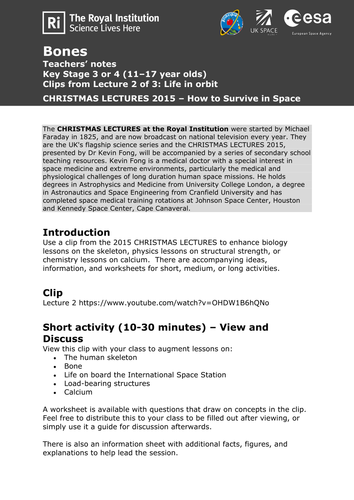





Biology lessons for 11-14 and 14-16 year- olds on the skeleton, physics lessons on structural strength, or chemistry lessons on calcium with short (10-30 minutes), medium (30-60 minutes) and long (60+ minutes) activities. They are based on video clips of the CHRISTMAS LECTURES from the Royal Institution, the UK's iconic science series on TV.
To use the resource, you'll need the Teachers Guide for the length of activity you want, alongside the video clip.
Video link:
Bones in space https://youtu.be/OHDW1B6hQNo
Short activity, view and discuss (10-30 minutes):
View this clip with your class to augment lessons on:
-The human skeleton
-Bone
-Life on board the International Space Station
-Load-bearing structures
-Calcium
A worksheet is available with questions that draw on concepts in the clip. Feel free to distribute this to your class to be filled out after viewing, or simply use it a guide for discussion afterwards.
There is also an information sheet with additional facts, figures, and explanations to help lead the session.
Medium activity: Bone analogs (30-60 minutes)
Tie the clip into a larger lesson on the structure and function of bone. Bone is a living tissue that reforms itself depending on the stresses it is put under. Without the constant force of gravity, bones deteriorate rapidly. Using paper and card, explore the relationship between density and strength and show the surprising strength of structures made from certain shapes.
Long activity: Soft bones (60+ minutes)
Explore calcium, the element that gives bones their strength, by turning chicken bones and eggs rubbery. This activity must take place over the course of at least two days to allow time for the reaction to take place. Consider beginning the activity before a weekend.
These resources can be adapted for any class in KS3 or KS4 and link to working scientifically, biology, physics and chemistry English curriculum objectives.
This resource is part of Tim Peake's Principia mission education programme, supported by the UK Space Agency and ESA.
To use the resource, you'll need the Teachers Guide for the length of activity you want, alongside the video clip.
Video link:
Bones in space https://youtu.be/OHDW1B6hQNo
Short activity, view and discuss (10-30 minutes):
View this clip with your class to augment lessons on:
-The human skeleton
-Bone
-Life on board the International Space Station
-Load-bearing structures
-Calcium
A worksheet is available with questions that draw on concepts in the clip. Feel free to distribute this to your class to be filled out after viewing, or simply use it a guide for discussion afterwards.
There is also an information sheet with additional facts, figures, and explanations to help lead the session.
Medium activity: Bone analogs (30-60 minutes)
Tie the clip into a larger lesson on the structure and function of bone. Bone is a living tissue that reforms itself depending on the stresses it is put under. Without the constant force of gravity, bones deteriorate rapidly. Using paper and card, explore the relationship between density and strength and show the surprising strength of structures made from certain shapes.
Long activity: Soft bones (60+ minutes)
Explore calcium, the element that gives bones their strength, by turning chicken bones and eggs rubbery. This activity must take place over the course of at least two days to allow time for the reaction to take place. Consider beginning the activity before a weekend.
These resources can be adapted for any class in KS3 or KS4 and link to working scientifically, biology, physics and chemistry English curriculum objectives.
This resource is part of Tim Peake's Principia mission education programme, supported by the UK Space Agency and ESA.
Something went wrong, please try again later.
This resource hasn't been reviewed yet
To ensure quality for our reviews, only customers who have downloaded this resource can review it
Report this resourceto let us know if it violates our terms and conditions.
Our customer service team will review your report and will be in touch.
£0.00
